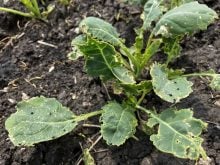Trials comparing weigh scale measurements to those from combine monitors found canola results were unreliable
A Manitoba farmer testing combine yield monitors says his results show they are reasonably accurate, but not for canola.
Adam Gurr, who farms near Rapid City, conducted more than 20 trials last year on wheat, soybeans, oats and canola, comparing yields recorded by the yield monitor and yields measured with a scale.
“We did a lot of comparisons on our farm this year between yield monitor and the scale. We compared 21 field scale trials. It amounted to about 250 reps (repetitions),” said Gurr, who runs Agritruth Research, which produces and sells independent agronomic data.
Read Also

Growing garlic by the thousands in Manitoba
Grower holds a planting party day every fall as a crowd gathers to help put 28,000 plants, and sometimes more, into theground
“With wheat, soybeans and oats, the yield monitor had a pretty strong correlation with what we were getting on the scale,” he said.
“When it came to canola yields, there was very little to no correlation between yield monitor data and what we were getting off the scale…. With canola there wasn’t any correlation, statistically.”
Gurr mentioned his research during a producer panel at last month’s Manitoba Agronomists Conference in Winnipeg.
He said he used a Lexion quantimeter and calibrated the yield monitor before doing the tests. He compared the yield monitor results to a scale 65 times for canola and 79 times for wheat.
He wanted to know if the yield monitor numbers would skew the results of an agronomic trial.
“When we were analyzing our trial data, we performed the statistical analysis on both sets of numbers to see if we would have arrived at the same conclusion,” Gurr said in an email.
“For canola, we arrived at a different conclusion six out of seven times. For wheat, it was two out of eight.”
Gurr said producers make decisions based on yield data, so it’s critical to know the accuracy of the yield measurement. For instance, relying on a yield monitor could compromise the validity of a strip trial comparing two varieties of canola.
“There’s a danger in making the wrong decision (based) on the yield monitor data…. I wouldn’t be concerned if it (the yield monitor) was consistently high or consistently low, but the problem with canola is it (the yield monitor) can be high on one strip and low on another strip,” Gurr said.
“If you’re looking at a whole field average, the yield monitor can look pretty accurate, but if you’re trying to detect a treatment effect, you might go down one strip and it’s five percent low and you come back down another treatment strip and it’s five percent high. So you’re showing a 10 percent difference in yield when there was no difference in yield.”
Gurr determined that the least significant difference (LSD), which is the smallest difference that is statistically significant, was larger with the yield monitor:
- The wheat LSD was 3.2 bushels per acre with the scale and 3.6 bu. per acre with the monitor.
- The canola LSD difference was two bu. per acre with the scale and 3.8 bu. per acre with the monitor.
Dan Hacault, who conducts research and collects data on his farm near Swan Lake, Man., agreed yield monitors aren’t suitable for on-farm trials.
“If you’re serious about doing large scale strip trials, a weigh scale on your grain cart is a necessity,” he said.
Gurr said he doesn’t know why the yield monitor performed well for wheat, oats and soybeans but not for canola.
In extreme cases, the monitor recorded canola yields that were 20 percent higher than the yields measured using a scale.
Claas spokesperson John Schofield said Gurr’s results are curious because most producers have positive comments about the Lexion yield monitor.
“The sensor has been really accurate,” he said.
“If we had an issue in a crop, I’d let you know. But a lot of farmers up in Western Canada really like that sensor. So we’re kind of surprised to hear that.”
Gurr didn’t test other yield monitors, but he said he has used other brands and observed that canola yields are inconsistent.
John Deere said this fall that yield monitors shouldn’t be used to generate yield maps.
“The data supplied by a combine’s yield metering system is often not accurate enough because the system cannot be calibrated to any harvest situation or because calibrating would disrupt the harvesting chain,” it said.
“As a result, the yield maps used are inaccurate and do not comply with the standards of precision farming.”
In August, the company said it is introducing Active Yield, a monitor with automated calibration to improve the reliability and accuracy of yield data.
Gurr will make his monitor-scale research public when he has finished summarizing the data.


















